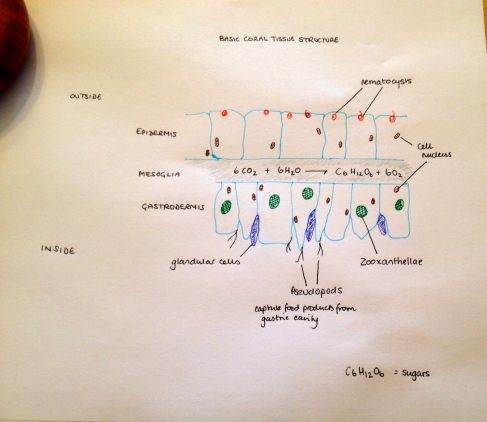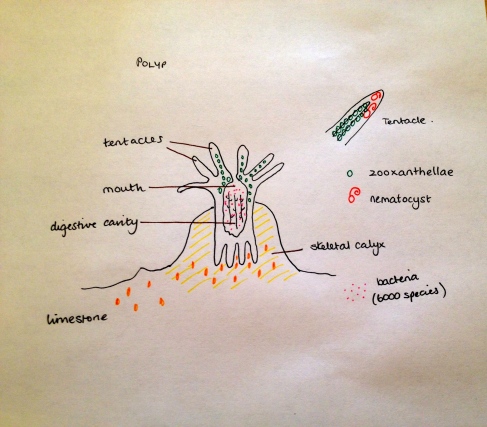This post was triggered by two events – one was a talk about coral reefs at a recent International Womens Club lunch (yes, I have become a woman who does lunch) and the other a wander along the coastal section of a nature reserve to the east of the island that was littered with huge chunks of old and rusted metal, possibly from metal barrels or vehicles. So yesterday I listened to two lectures on iTunesU about coral reefs (iBioSeminars, Dr Knowlton from the Smithsonian Institute).
Bermuda is the northernmost coral reef at 32 degrees north, sitting on top of a very very old volcano. The sea mountain itself is basalt but it is topped with limestone made by organisms that fix calcium carbonate from the water such as corals.
What exactly are corals?
Definitely animal, and the individual in the colony is called a polyp.
One I prepared earlier!
The polyp is effectively a column with a mouth at the top, it is radially symmetrical.
They all have nematocysts – harpoons of sting cells to catch prey.
Inside the coral is a community of algae, bacteria, archaea, fungi and viruses, which are essential for the health of the coral.
Zooxanthellae are algae that live in corals – under the microscope they look like small green balls. They use sunlight to make sugars that the corals can use to grow.

Coral animals are hard to classify – even for the experts.
They all belong to the Phylum Cnidaria
Not all of them will make rock, some serve as anchors or to attract fish.
There are different kinds and four groups make stony skeletons:
True corals, Blue corals, Organ pipe corals, Fire corals (this one hurts lots)
Then there are sea fans and soft corals which don’t build rocky skeletons.
They grow in complex shapes and one family can make several different shape colonies.
Corals do actually reproduce sexually, releasing eggs and sperm in a mass spawning event that occurs a set time after the full moon – the timing is down to a specific hour after sunset and studies have shown for example that one species will spawn at two hours after sunset and then another species on the same night but four hours after sunset. Such tightly controlled reproductive life would be something of a bind for humans.
This next bit is important:
Coral reefs face risks as great as that for the rain forests
The risks come from:
- Pollution
- Overfishing
- Rising sea temperatures
- Coral diseases
All of these lead to a process called coral bleaching.
Coral bleaching is destroying the coral reefs around the world.
It is named “bleaching” because the corals lose their colors.
It occurs when the algae get stressed and stop photo synthesizing.
They are stressed when it is too hot, too sunny, or the water is too acidic.
So the algae die and the coral spits them out – so instead of seeing the algae inside you can see through the polyps to the stony skeleton which is white.
Without the algae the coral cannot build skeletons so cannot grow.
One cause of bleaching I had not fully appreciated is sun tan lotion where the ultraviolet filtering chemicals dissolve in the water in as short a time as fifteen minutes. Biodegradable sunscreens are apparently available (Badger; Caribbean Solutions) so will be on my shopping list for next summer.
Corals also suffer from diseases, with unimaginative names such as “white band disease” and “black band disease”. But as yet it isn’t known which bacteria or viruses might cause the diseases because they don’t yet know the normal microbiological life in coral. There are over 6000 identified species of coral bacteria!
One of the theories of coral disease is linked to seaweeds producing sugars that get absorbed into the coral which cannot handle them – diabetic coral if you like. It is a problem because of seaweed overgrowth where weed-eating fish have been decimated by overfishing. They have documented coral reef destruction with increasing density of seaweeds in the reef area. Seaweed grows much faster than coral and so tends to take over pretty quickly.
Coral reefs are being lost at a rate of 1-2% per year.
Why does it matter?
For Bermuda,
- The reef protects the island from the force of tropical storms – without it each hurricane could be as damaging as Fabian was in 2005.
- The reef provides a habitat for commercially important fish
- Recently there has been pharmaceutical interest – some species of cone snails that live on the reefs can produce analgesics.
- Being the most northerly coral reef, thousands come to the island to see the reefs and fish. So loss of the reef would seriously damage Bermudian economy.
- The reef is a natural boundary that protects the shoreline from the power of the waves – inside the reef the waves will be typically several feet lower and so less coastal erosion occurs.
For other places such as the Phillipines some areas are highly dependent on the reef for food and employment, so their economies would be seriously affected by loss of the reefs.
What can I do?
- Take only pictures, leave only bubbles.
- Choose my seafood wisely – only sustainable fish
- Don’t buy coral jewellery
- Reduce, reuse and recycle
- Plant a tree – trees reduce run off into the oceans
- Take away my own rubbish, but also pick up a piece of other rubbish each time I visit a beach
- Stay informed and spread the word …


